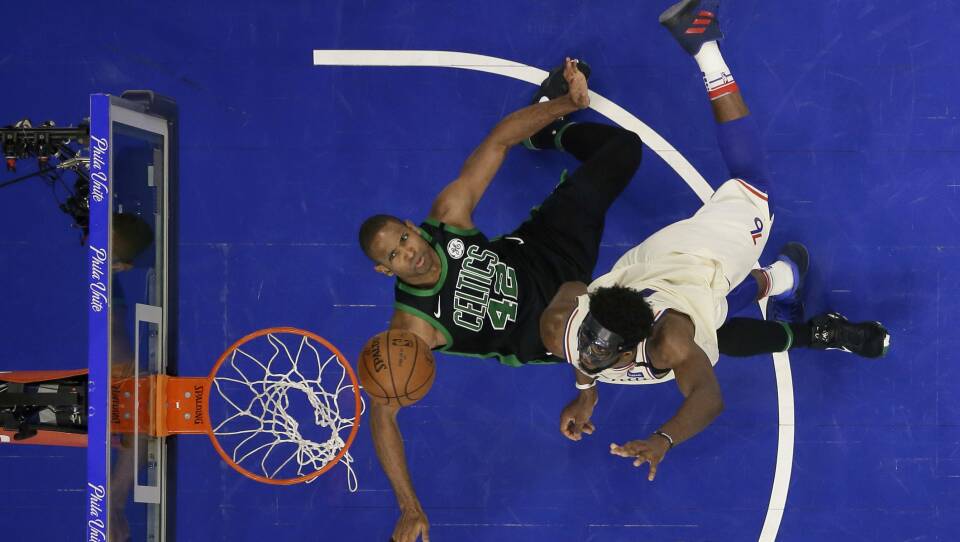Standing courtside at the Boston Garden as the Celtics and Philadelphia 76ers warm up before a recent playoff game, I couldn't help but be struck by the sheer size and athleticism of the players. On Wednesday, millions will watch these impressive young athletes fight it out on the court in Game 5 of this playoff series.
But there’s another battle quietly going on far out of view; one of Bayesian statistics, spaciotemporal data, and neural networks.
"When I started I was either the first or the second employee focused on modern statistical analysis. In the league," said Boston Celtics Assistant General Manager and Team Counsel Mike Zarren.
For more than a decade, Zarren has been leading the Celtics' dive into big-data.
"Now almost every team, if not every team, [has] at least one, if not more people, doing this stuff," he explained.
This “stuff” is known as analytics. And few teams in the league have embraced it as wholeheartedly as the Celtics and the 76ers, said Marcus Hayes, longtime sports columnist for the Philadelphia Inquirer/Daily News.
"The Sixers probably have the most analytics-saturated team in the league," he explained. "Though certainly Houston and Boston are really advanced in the analytics and sports science realm as well."
Advanced analytics in sports is nothing new. If you’ve seen the film "Moneyball," you have a sense of how the rise of the statistical geek began transforming the game of baseball in the 1990s.
"Baseball’s just easier to analyze," said Zarren. "There’s a bunch of discreet events: The ball gets thrown; someone either swings or doesn’t swing; they hit it or they don’t hit it; someone catches it or they don’t catch it."
But basketball? There are 10 players all constantly moving, endless possible angles and positions, and decision-making is dynamically affected by a shot clock. How do you even begin to get your head around all that?
A huge breakthrough came courtesy of the Celtics back in 2010.
"We were the first team in the NBA to install a system of 10 cameras in the rafters that are tracking the players' positions, x-and-y, and the ball, x-y-and-z, at 30 frames per second."
More teams followed suit. In 2013, the league installed them in all arenas and now makes the data captured available to all teams after every game.
For teams like the Celtics and the Sixers, it’s been a game changer.
"I was talking to this friend of mine who works for a baseball team," said Alex Rucker, who heads up the Sixers' 10-person analytics department. "Baseball is almost solved. I don’t think basketball is solvable."
It’s this unsolvable nature of the beast that fires up the big brains on his team, who have expertise in everything from computer science to mathematics to statistics. Many hold PhD's in a range of disciplines, such as computational complexity and computational neuroscience.
"There's no ultimate strategy [in basketball]," said Rucker. "It's not, 'Do this and you will win.' It's, 'Do this today against them and you might win.'"
This rise of analytics in the NBA is no doubt changing the game. It’s not a coincidence that the 3-point shot is being taken league-wide in record numbers. But the real leading edge is being forged on the other side of the ball, says Zarren.
"Especially on defense, the box score just never quantified a bunch of things," he said. "Now we can actually track all of those screens and picks. As long as it involves movement on the court, we can probably keep track of it."
Coaches are using this new, predictive information to help decide everything from which players to substitute when, to the ideal position on the court for a particular player to receive a pass against a particular team.
But exactly how these teams are getting there is anyone’s guess. Many of these "analyticians” can code and develop their own software. And they are a notoriously cagey bunch, seeking to maintain a competitive advantage in the burgeoning field. The Celtics won’t even say exactly how many people they have working on it.
"There’s a lot of people who are really good at analyzing continuous motion special data and a lot of people who are really good at machine learning," said Zarren.
A few weeks back, Philly sportswriter Marcus Hayes got a rare look at something the Sixers call “a deck:” a custom-designed, 13-page booklet their analytics team prepares for the coaches before each game. Hayes says he was floored by the specificity and level of detail.
"I’ve watched, maybe, 10,000 basketball games in the NBA," he said. "And watching that game and understanding what the game plan had to be according to the analytics numbers, it was like watching basketball for the first time, or watching basketball translated."
Still, you need not be an Einstein to enjoy the game. No matter how much basketball is transformed in the coming years by big data, the only numbers that truly matter will be the ones that have always mattered: The final score when the clock reads all zeros.
Something got you curious? Let me know. Email me at curiositydesk@wgbh.org. Who knows, I might just look into it for you.





